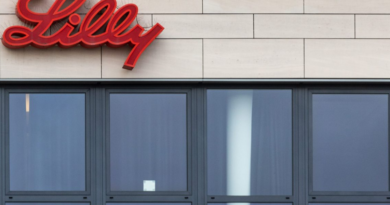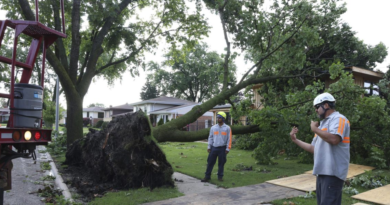'Office is toxic': Cranes disappear nationwide as commercial real estate crunch hits downtowns
When Rahm Emanuel ran Chicago and wanted to boast about the health of the city, the then-mayor pointed to the number of construction cranes across the skyline — 60 at the end of 2017.
Almost five years after he left office, that number has dwindled to the single digits. There was just one groundbreaking on an office building last year, and zero are expected in 2024.
It’s a stark turnaround for the Windy City and a sign of its economic struggles as higher interest rates, inflation and weak demand for office space squelch appetite for new development.
The commercial real estate crisis brought on by the rise of remote work and higher borrowing costs has sent US office values tumbling across the US, leading to mounting turmoil for banks and making it less appealing for lenders to offer financing for new buildings. Construction has slowed from San Francisco to New York, where JPMorgan Chase & Co.’s new headquarters, opening in 2025, is set to be the largest office tower to debut for several years.
“Office is toxic,” said Bob Clark, executive chairman and founder of developer Clayco, which moved its headquarters to Chicago about a decade ago. “A lot of people had their projects based on low interest rates, and today that actually just doesn’t pencil.”
The decline in new development is particularly steep in Chicago, where only nine cranes were operating as of August, according to the last official count from construction-advisory company Rider Levett Bucknall. That compared with 29 in February 2020, just before the onset of the Covid-19 pandemic. The 69% drop was more pronounced than anywhere but Manhattan among 12 major US business centers tracked by the firm.
The next crane count is taking place this month and is expected to show even more declines in Chicago, said Warren Todd, head of Rider Levett Bucknall’s Chicago office.
In a city where Emanuel touted the number of cranes as a sign of “economic vitality, vibrancy and versatility,” the lack of construction presents a challenge to reviving a downtown plagued by high office vacancies. Mayor Brandon Johnson, nine months into the job, is confronting falling fiscal revenue and — like his predecessor, Lori Lightfoot — a relatively strained relationship with the business community.
Jason Lee, a senior adviser for Johnson, said counting cranes is a good measure of economic development, but not the only one. He pointed to corporate expansions, small-business growth, and increased cultural and entertainment revenue as examples of positive activity.
“With inflation and higher interest rates, the city now faces a different environment,” he said, adding that the administration will release additional economic-development plans soon.
For now, Johnson’s main real estate-related measure is a proposed increase in transfer tax for property deals of $1 million or more to provide funding for homeless services. The so-called Mansion Tax proposal, which will be on the ballot in March, applies to sales of both residential and commercial buildings, sparking concern among investors that it will further hurt prices.
Emanuel, now US ambassador to Japan, declined to comment for this story.
Empty Offices
Weakness in commercial real estate has gained heightened attention this month after lenders from New York Community Bancorp to Japan’s Aozora Bank and Germany’s Deutsche Pfandbriefbank AG sparked investor concern about souring loans. The US office market has been hit particularly hard by falling values, with property prices declining 22% in the 12 months through January, according to real estate analytics firm Green Street.
Chicago is illustrative of the strains. Its office vacancy rate reached 21% at the end of last year, according to Jones Lang LaSalle Inc. Office leasing fell 17% in the fourth quarter from 2022 levels and 53% compared with the previous three months, data from the real estate broker show. In the eastern part of the Loop, the central business district, the owners of the iconic Chicago Board of Trade building handed the keys back to lenders.
While more workers are returning to offices — occupancy on peak weekdays is at almost 70%, the second-highest in the country, according to JLL — the uncertainty of schedules and varying plans by employers has hurt demand for space, said Brian Atkinson, managing director for Chicago at Hines.
“Is it three days a week? Is it four days a week? Is it five days a week? Is it 100% in office?” he said, adding that he wouldn’t be surprised if there’s no new commercial construction announced in Chicago this year. “That uncertainty has led to shorter commitments from actual users and a reluctance in general to make big commitments.”
The office downturn can filter through the economy. Fewer workers mean downtown businesses generate less sales tax revenue. Reduced commercial real estate assessments shift the property-tax burden to the city’s homeowners, threatening to reduce Chicago’s appeal to residents over the longer term. And empty streets aren’t conducive to safety. The city is already struggling with persistently high crime rates, with incidents up 55% since 2019.
New buildings bring construction jobs and add a sense of vibrancy to neighborhoods that is important for both attracting tenants and luring employees back to offices, said Alex Najem, chief executive officer of Fulton Street Cos., the developer behind the only Chicago office project to break ground in 2023.
The property in Fulton Market, an area just west of the Loop that’s popular with tech firms, is set to be a 409,000-square-foot office building. Lead investor Shanna Khan, daughter of billionaire Jacksonville Jaguars owner Shahid Khan, is providing financing along with a $230 million loan from Manulife Financial Corp. and Bank OZK.
The location, leasing activity and backing from a high-net-worth family provided confidence in the development for both lenders and the city, Najem said. He sees demand rebounding for new offices with bespoke amenities in top locations, while older properties languish. The amount of money and work required to retrofit those buildings is “literally impossible,” he said.
“People deserve to spend a majority of their life in a more exciting, more healthy environment,” Najem said. “New construction, whether it be in a business district or a neighborhood like Fulton Market, you can afford to do that. You couldn’t pay me to take a building in the Loop. I wouldn’t take it for free.”
Pockets of Growth
Other pockets of the Chicago real estate market are attracting investors. Amancio Ortega, the billionaire founder of the Zara clothing chain, bought a 45-story residential building for $232 million. Developers Shapack Partners and CRG landed an $84 million loan for a 29-story apartment tower. And a crane is operating for one prominent new building: the Obama Presidential Center, set for completion by the end of next year.
“Just because there’s a lack of new development, doesn’t mean that money isn’t being spent,” said Margie Baran, managing director for projects at JLL in Chicago. “Most of the major projects happening in Chicago right now are related to entertainment, cultural institutions, and sports.”
For the rest of Chicago’s commercial property market, returning to normal will take awhile. Hines’s Atkinson said new construction may be announced again in 2025 — meaning towers wouldn’t actually arrive until 2028 or 2029. For building to rebound, interest rates will need to come down, investors will need more certainty on the economic outlook and people will need to return to offices in a more meaningful way, he said.
“Mayor Emanuel was counting cranes at a time of economic expansion, economic growth — we’re quite clearly going through a national slowdown,” he said. “It was a different economic time.”




